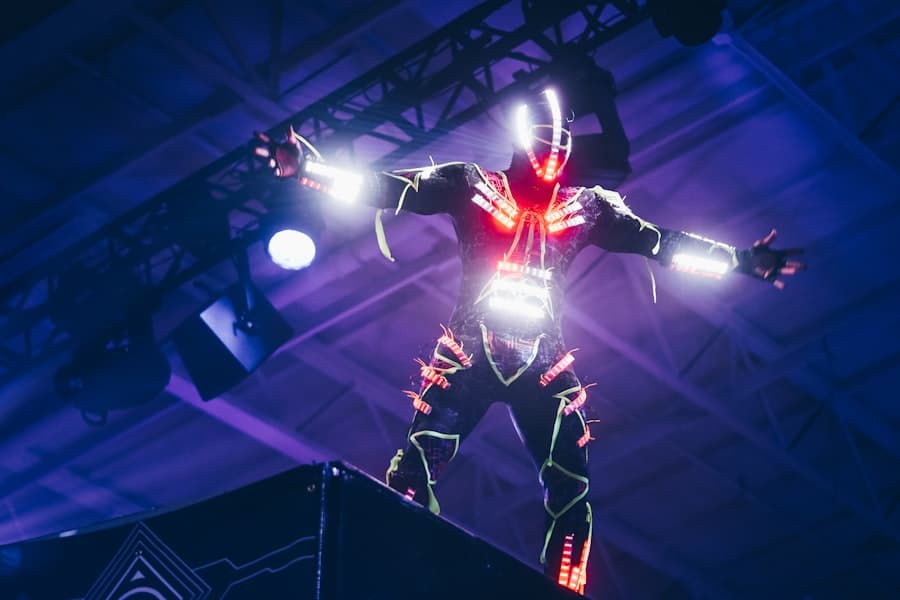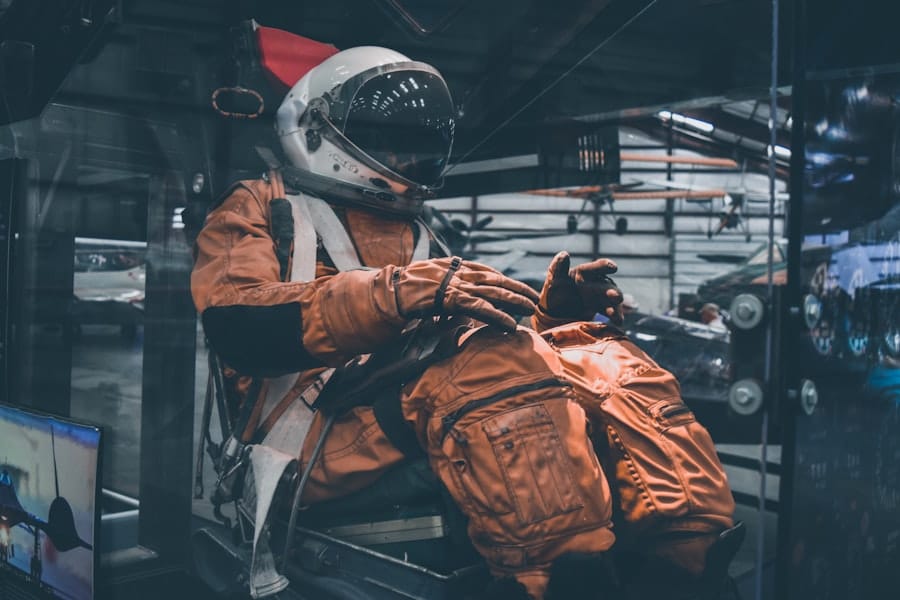The exploration of outer space has long captivated human imagination, serving as a frontier for scientific discovery and technological advancement. As missions to Mars and beyond become increasingly feasible, the need for advanced life-support systems has never been more critical. Enter AI-powered space suits, a revolutionary development that promises to enhance the safety and efficiency of astronauts during their missions.
These suits are not merely protective gear; they are sophisticated systems equipped with artificial intelligence that can monitor health, provide real-time data, and even assist in decision-making processes. The integration of AI into space suits represents a paradigm shift in how we approach human spaceflight, merging cutting-edge technology with the age-old quest for exploration. The concept of AI-powered space suits is rooted in the necessity for enhanced human performance in the harsh environment of space.
Traditional space suits, while effective in providing life support and protection from the vacuum of space, lack the adaptive capabilities that modern technology can offer. By incorporating AI, these suits can analyze vast amounts of data from various sensors, enabling them to respond dynamically to the astronaut’s physiological state and environmental conditions. This innovation not only aims to improve astronaut safety but also seeks to optimize their performance during missions that may last months or even years.
Key Takeaways
- AI-powered space suits are revolutionizing space exploration by integrating advanced technology to enhance astronaut safety and performance.
- Real-time health monitoring plays a crucial role in space exploration by providing immediate feedback on astronaut health and well-being.
- Advancements in AI technology for space suits include the use of machine learning algorithms to analyze and predict astronaut behavior and health patterns.
- AI-powered space suits offer potential benefits such as improved decision-making, enhanced safety, and increased efficiency for astronauts during space missions.
- Challenges and limitations of AI-powered space suits include the need for reliable power sources, potential malfunctions, and the ethical considerations of privacy and data security.
The Role of Real-Time Health Monitoring in Space Exploration
Real-time health monitoring is a cornerstone of AI-powered space suits, providing astronauts with critical insights into their physical condition while they are away from Earth. In the microgravity environment of space, human physiology undergoes significant changes, including muscle atrophy, bone density loss, and alterations in cardiovascular function. These changes can pose serious risks to astronauts’ health and mission success.
By employing advanced sensors embedded within the suit, real-time health monitoring systems can track vital signs such as heart rate, blood pressure, oxygen saturation, and even biochemical markers indicative of stress or fatigue. The ability to monitor health metrics in real time allows for immediate intervention if an astronaut’s condition deteriorates. For instance, if an astronaut’s heart rate spikes or oxygen levels drop below a safe threshold, the AI system can alert them to take necessary actions, such as adjusting their activity level or initiating emergency protocols.
This proactive approach not only enhances individual safety but also contributes to the overall success of long-duration missions by ensuring that astronauts remain in optimal health throughout their journey.
Advancements in AI Technology for Space Suits

The advancements in AI technology that have made AI-powered space suits a reality are multifaceted and stem from various fields, including machine learning, data analytics, and sensor technology. Machine learning algorithms can process vast amounts of data collected from the suit’s sensors, identifying patterns and anomalies that may indicate potential health issues. For example, by analyzing historical data from previous missions alongside real-time metrics, AI can predict an astronaut’s likelihood of experiencing fatigue or other health-related challenges based on their current activity levels and physiological responses.
Moreover, the integration of advanced sensor technology has significantly enhanced the capabilities of these suits. Wearable sensors can now measure a wide array of physiological parameters with remarkable accuracy. Innovations such as flexible biosensors that adhere to the skin allow for continuous monitoring without hindering mobility.
These sensors can detect changes in sweat composition, providing insights into hydration levels and electrolyte balance—critical factors for maintaining astronaut health during extended missions. The synergy between AI algorithms and advanced sensor technology creates a robust framework for real-time health monitoring that is both comprehensive and responsive.
Potential Benefits of AI-Powered Space Suits for Astronauts
The potential benefits of AI-powered space suits extend beyond mere health monitoring; they encompass a wide range of enhancements that can significantly improve astronauts’ overall experience and performance during missions. One of the most notable advantages is the increased autonomy these suits provide. With AI systems capable of analyzing data and making recommendations in real time, astronauts can focus more on their scientific tasks rather than constantly monitoring their own health or relying on ground control for guidance.
Additionally, AI-powered space suits can facilitate better communication between astronauts and mission control. By integrating communication systems with AI capabilities, astronauts can receive instant feedback on their performance and health status without needing to initiate contact with ground personnel. This seamless flow of information can enhance situational awareness and enable more efficient decision-making during critical moments.
Furthermore, the ability to simulate various scenarios using AI can prepare astronauts for unexpected challenges they may face during their missions.
Challenges and Limitations of AI-Powered Space Suits
Despite the promising advancements associated with AI-powered space suits, several challenges and limitations must be addressed before they can be fully realized in space exploration. One significant concern is the reliability of AI systems in extreme environments.
Ensuring that these systems function reliably under such conditions is paramount for astronaut safety. Another challenge lies in the complexity of integrating multiple technologies into a single suit without compromising its functionality or comfort. The addition of sensors, communication devices, and AI algorithms must be carefully balanced to avoid creating a cumbersome or heavy suit that could hinder an astronaut’s mobility.
Moreover, there is a need for rigorous testing and validation processes to ensure that these advanced features do not introduce new risks or complications during missions.
Integration of AI-Powered Space Suits with Spacecraft Systems

Real-time Data Analysis for Enhanced Safety
For instance, data collected by the suit’s health monitoring system could be transmitted directly to the spacecraft’s central computer, allowing for real-time adjustments to environmental controls based on an astronaut’s physiological needs. This real-time data analysis enables prompt responses to any health concerns, ensuring the safety and well-being of astronauts during their space missions.
Optimized Resource Allocation for Improved Mission Outcomes
Furthermore, this integration could facilitate enhanced mission planning and execution. By analyzing data from both the suit and spacecraft systems, mission control could optimize resource allocation—such as oxygen supply or power usage—based on individual astronaut needs during different phases of a mission. This level of coordination could lead to more efficient use of resources and improved overall mission outcomes.
Enhanced Mission Planning and Execution
The integration of AI-powered space suits with spacecraft systems could also revolutionize mission planning and execution.
Ethical and Privacy Considerations in Real-Time Health Monitoring
As with any technology that involves personal data collection, ethical and privacy considerations are paramount when it comes to real-time health monitoring in AI-powered space suits. The continuous collection of sensitive health information raises questions about data ownership, consent, and potential misuse. Astronauts must be assured that their health data will be handled responsibly and used solely for enhancing their safety and performance during missions.
Moreover, there is a need for transparent policies regarding data sharing between astronauts and mission control. Clear guidelines must be established to ensure that astronauts are informed about what data is being collected, how it will be used, and who will have access to it. Balancing the benefits of real-time monitoring with respect for individual privacy rights is crucial in fostering trust between astronauts and mission planners.
The Future of AI-Powered Space Suits and Space Exploration
Looking ahead, the future of AI-powered space suits appears promising as advancements in technology continue to evolve at an unprecedented pace. As we prepare for more ambitious missions to destinations like Mars or even beyond our solar system, the need for sophisticated life-support systems will only grow more critical. The ongoing development of AI capabilities will likely lead to even more intelligent suits that can adapt not only to an astronaut’s physical condition but also to changing environmental factors encountered during deep-space travel.
Moreover, as we gain more experience with these technologies through testing on the International Space Station (ISS) and future lunar missions under NASA’s Artemis program, we will refine our understanding of how best to implement AI-powered systems in space exploration contexts. The lessons learned from these early applications will pave the way for future innovations that could redefine human capabilities in space—transforming not just how we explore but also how we understand our own biology in extreme environments. In conclusion, AI-powered space suits represent a significant leap forward in human space exploration technology.
By combining real-time health monitoring with advanced AI capabilities, these suits promise to enhance astronaut safety, performance, and overall mission success while addressing ethical considerations surrounding data privacy. As we continue to push the boundaries of exploration beyond Earth’s atmosphere, these innovations will play a crucial role in ensuring that humanity can thrive in the cosmos.
If you’re interested in the latest technology trends, you may also want to check out this article on the best laptops for teachers in 2023. Just like the advancements in AI-powered space suits, having the right tools can greatly enhance productivity and efficiency in various fields. Whether you’re a teacher looking for a reliable laptop for remote teaching or a professional in need of top-notch scheduling software, staying informed about the latest tech developments is key.
FAQs
What are AI-powered space suits with real-time health monitoring?
AI-powered space suits with real-time health monitoring are advanced space suits equipped with artificial intelligence technology that can monitor the health and vital signs of astronauts in real-time during space missions. These suits are designed to provide immediate feedback on the astronaut’s health status and can alert mission control in case of any medical emergencies.
How do AI-powered space suits work?
AI-powered space suits use a combination of sensors, AI algorithms, and real-time data processing to monitor the astronaut’s vital signs such as heart rate, blood pressure, oxygen levels, and body temperature. The AI algorithms analyze the data and can detect any anomalies or health issues, providing immediate feedback to the astronaut and mission control.
What are the benefits of AI-powered space suits with real-time health monitoring?
The benefits of AI-powered space suits with real-time health monitoring include the ability to continuously monitor the astronaut’s health, early detection of health issues, immediate response to medical emergencies, and overall improved safety and well-being of astronauts during space missions.
What is the future potential of AI-powered space suits with real-time health monitoring?
The future potential of AI-powered space suits with real-time health monitoring is vast, with the possibility of further advancements in AI technology, integration with other space systems, and the potential to support longer and more complex space missions, including missions to Mars and beyond. These suits could also have applications in healthcare and remote monitoring on Earth.

